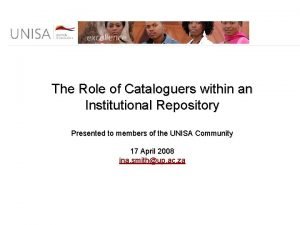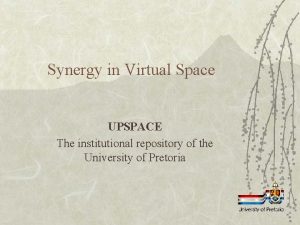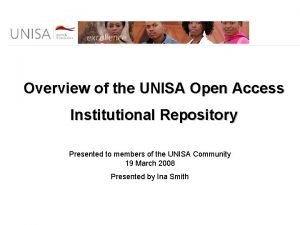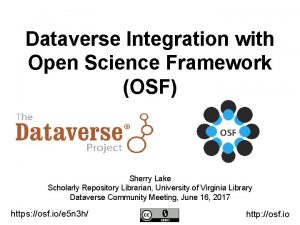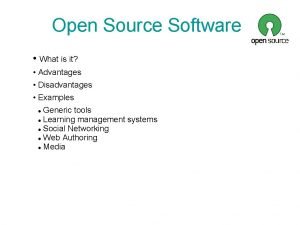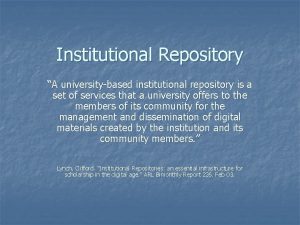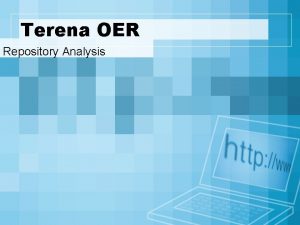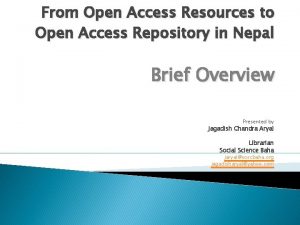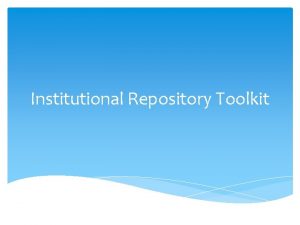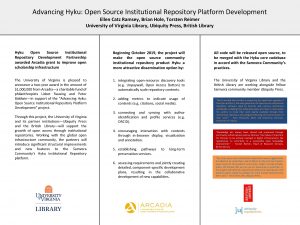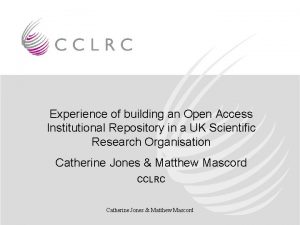Open Access Open Source and the Institutional Repository









- Slides: 9

Open Access Open Source and the Institutional Repository Richard Jones

Some Shaky Analogies ● Repositories of Source Code ● Repositories of Assets ● Permissive/Copyleft Licensing ● Creative Commons Licensing ● OS vs Proprietary ● ● Service Providers ● OA Repositories vs non-OA publishers Open Access Publisher/Repository provider

defining the fuzziness ● ● ● Open Source has a broader remit than just software Closed source and commercial service provision are very different things The degree of open-ness is defined by the licensing conditions: BSD, GPL. . . CC varieties: share alike, non-commercial. . .

some OSS advantages ● ● ● There isn't much in the way of closed source repository packages (weak) Interoperability can be affected by being locked into vendors and proprietary formats (strong) Repository use cases can be mould-breakingly complex (proxy) [next slide] There are plenty of open source, stable and mature repository packages (weak) [slide after next] Preservation opportunities can be damaged by the use of proprietary storage mechanisms (sometimes strong)

repository use cases can be complex Publications System Academic Web Pages Internal Repository Administrators Public Repository Mirror The World

plenty of OSS packages The Big Three

final notes ● ● ● Open Access has partly sprung out of a community of OSS developers: academic institutions, research organisations, etc. Check the licensing conditions of the package – many OSS variations exist Commercial companies are starting to come around to the OSS approach. Even Microsoft are funding OSS projects, and may even be interested in EPrints for Windows!

Thanks for listening Richard Jones Web and Database Technology Specialist Imperial College London richard. d. jones@imperial. ac. uk This work is licenced under the Creative Commons Attribution-Non-Commercial-Share Alike 2. 0 UK: England & Wales License. To view a copy of this licence, visit http: //creativecommons. org/licenses/by-nc-sa/2. 0/uk/ or send a letter to Creative Commons, 559 Nathan Abbott Way, Stanford, California 94305, USA.

References Jones, R and Andrew, T (2005) “Open Access, Open Source and e-theses: the development of the Edinburgh Research Archive”, Program, 39 (3), 198 -212 Jones, R, Andrew, T, Mac. Coll, J (2006) “The Institutional Repository” Oxford: Chandos Publishing ARNO - http: //arno. uvt. nl/~arno/site/ CDS Invenio (formerly CDSWare) - http: //cdsware. cern. ch/invenio/index. html Di. VA - http: //www. diva-portal. org/about. xsql Do. KS - http: //doks. khk. be/ DSpace - http: //www. dspace. org/ Eprints. org - http: //www. eprints. org/ ETD-db - http: //scholar. lib. vt. edu/ETD-db/ E-Doc - http: //w 3. rz-berlin. mpg. de/eda/ Fedora - http: //www. fedora. info/ Greenstone - http: //www. greenstone. org/ i-Tor - http: //www. i-tor. org/en/ My. Co. Re - http: //www. mycore. de/engl/index. html OPUS - http: //elib. uni-stuttgart. de/opus/
 Unisa institutional repository
Unisa institutional repository Upspace institutional repository
Upspace institutional repository Unisa institutional repository
Unisa institutional repository Open science framework data repository
Open science framework data repository Open innovation open science open to the world
Open innovation open science open to the world Terminal access controller access-control system
Terminal access controller access-control system Terminal access controller access-control system
Terminal access controller access-control system Sisi in entrepreneurship
Sisi in entrepreneurship Roles and importance of institutional investors
Roles and importance of institutional investors Disadvantages of using open source software
Disadvantages of using open source software
